Hydroxyethyl starch versus other fluids for non-septic patients in the intensive care unit: a meta-analysis of randomized controlled trials
- PMID: 25886952
- PMCID: PMC4404666
- DOI: 10.1186/s13054-015-0833-9
Hydroxyethyl starch versus other fluids for non-septic patients in the intensive care unit: a meta-analysis of randomized controlled trials
Abstract
Introduction: Use of hydroxyethyl starch (HES) in septic patients is reported to increase the mortality and incidence of renal replacement therapy (RRT). However, whether or not use of HES would induce the same result in non-septic patients in the intensive care unit (ICU) remains unclear. The objective of this meta-analysis was to evaluate 6% HES versus other fluids for non-septic ICU patients.
Methods: Randomized controlled trials (RCTs) were searched from Pubmed, OvidSP, Embase database and Cochrane Library, published before November, 2013. A meta-analysis was made on the effect of 6% HES versus other fluids for non-septic ICU patients, including mortality, RRT incidence, bleeding volume, red blood cell (RBC) transfusion and fluid application for non-septic patients in ICU.
Results: Twenty-two RCTs were included, involving 6,064 non-septic ICU patients. Compared with the other fluids, 6% HES was not associated with decreased overall mortality (RR = 1.03, 95%CI: 0.09 to 1.17; P = 0.67; I(2) = 0). There was no significant difference in RRT incidence, bleeding volume and red blood cell transfusion between 6% HES group and the other fluid groups. However, patients in HES group received less total intravenous fluids than those receiving crystalloids during the first day in ICU (SMD = -0.84; 95%CI: -1.39 to -0.30; P = 0.003, I(2) = 74%).
Conclusions: This meta-analysis found no increased mortality, RRT incidence, bleeding volumes or RBC transfusion in non-septic ICU patients, but the sample sizes were small and the studies generally were of poor quality.
Figures
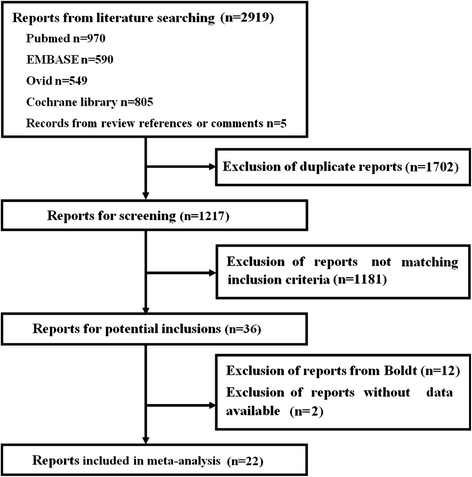
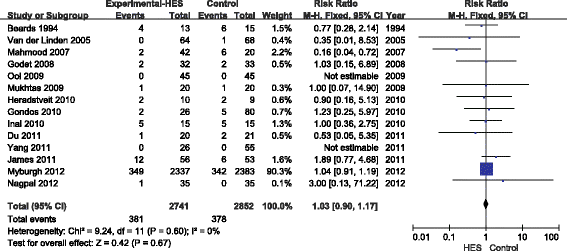
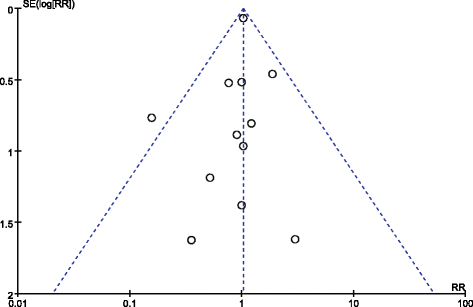
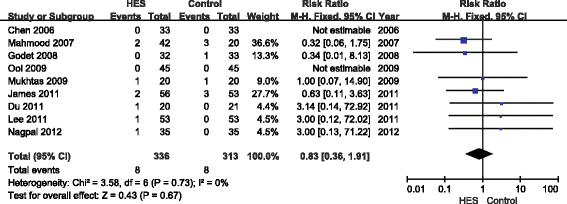
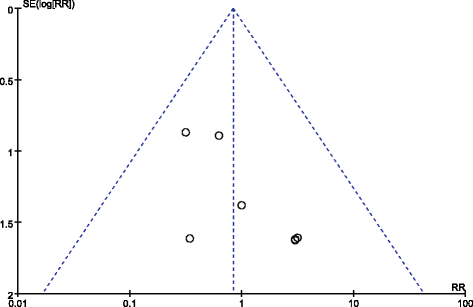
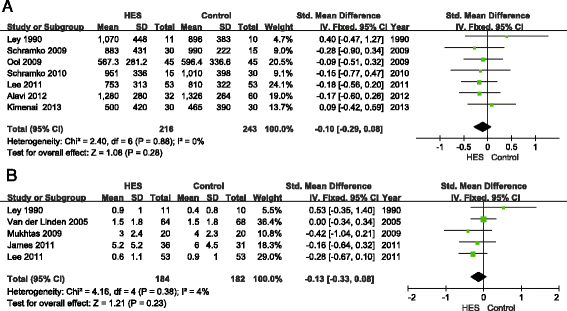
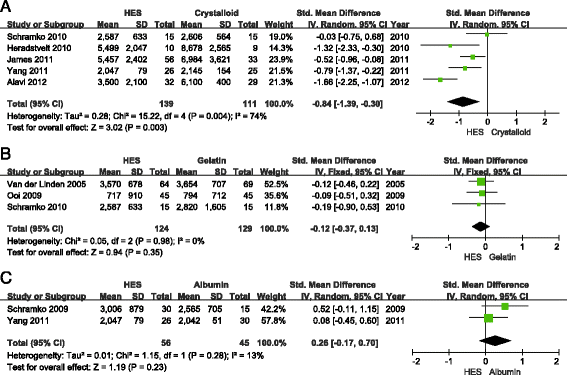
Comment in
-
Faulty risk-of-bias assessment in a meta-analysis of hydroxyethyl starch for nonseptic ICU patients.Crit Care. 2015 Oct 8;19:357. doi: 10.1186/s13054-015-1080-9. Crit Care. 2015. PMID: 26446864 Free PMC article. No abstract available.
Similar articles
-
Fluid resuscitation with hydroxyethyl starches in patients with sepsis is associated with an increased incidence of acute kidney injury and use of renal replacement therapy: a systematic review and meta-analysis of the literature.J Crit Care. 2014 Feb;29(1):185.e1-7. doi: 10.1016/j.jcrc.2013.09.031. Epub 2013 Oct 22. J Crit Care. 2014. PMID: 24262273
-
Association of high volumes of hydroxyethyl starch with acute kidney injury in elderly trauma patients.Injury. 2015 Jan;46(1):105-9. doi: 10.1016/j.injury.2014.08.039. Epub 2014 Sep 4. Injury. 2015. PMID: 25240412
-
Hydroxyethyl starch for fluid resuscitation in critically ill patients.Can J Anaesth. 2013 Jul;60(7):709-13. doi: 10.1007/s12630-013-9936-4. Epub 2013 Apr 20. Can J Anaesth. 2013. PMID: 23604905
-
Safety evaluation on low-molecular-weight hydroxyethyl starch for volume expansion therapy in pediatric patients: a meta-analysis of randomized controlled trials.Crit Care. 2015 Mar 10;19(1):79. doi: 10.1186/s13054-015-0815-y. Crit Care. 2015. PMID: 25887704 Free PMC article. Review.
-
Infusion of hydroxyethyl starch-containing fluids.Minerva Anestesiol. 2013 Sep;79(9):1088-92. Minerva Anestesiol. 2013. PMID: 24042155
Cited by
-
Faulty risk-of-bias assessment in a meta-analysis of hydroxyethyl starch for nonseptic ICU patients.Crit Care. 2015 Oct 8;19:357. doi: 10.1186/s13054-015-1080-9. Crit Care. 2015. PMID: 26446864 Free PMC article. No abstract available.
-
Hydroxyethyl starch for volume expansion after subarachnoid haemorrhage and renal function: Results of a retrospective analysis.PLoS One. 2018 Feb 15;13(2):e0192832. doi: 10.1371/journal.pone.0192832. eCollection 2018. PLoS One. 2018. PMID: 29447255 Free PMC article.
-
Faulty risk-of-bias assessment in a meta-analysis of hydroxyethyl starch for non-septic ICU patients: a rebuttal.Crit Care. 2015 Dec 24;19:444. doi: 10.1186/s13054-015-1168-2. Crit Care. 2015. PMID: 26699365 Free PMC article. No abstract available.
-
Choice of fluids in critically ill patients.BMC Anesthesiol. 2018 Dec 22;18(1):200. doi: 10.1186/s12871-018-0669-3. BMC Anesthesiol. 2018. PMID: 30579331 Free PMC article. Review.
-
Colloids versus crystalloids for fluid resuscitation in critically ill people.Cochrane Database Syst Rev. 2018 Aug 3;8(8):CD000567. doi: 10.1002/14651858.CD000567.pub7. Cochrane Database Syst Rev. 2018. PMID: 30073665 Free PMC article.
References
Publication types
MeSH terms
Substances
LinkOut - more resources
Full Text Sources
Other Literature Sources

